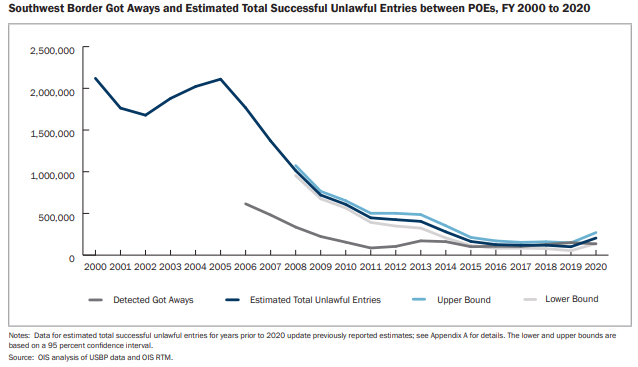
Ever since Joe Biden became President we’ve been reading and hearing about the disastrous situation at the southern border. Throughout 2021 and 2022, every month seemed to bring record numbers of “apprehensions”; and on September 30, 2022, the fiscal year ended with almost 2.4 million apprehensions—the highest ever recorded. In a recent poll, more than half of Americans agreed that it was completely or somewhat true that the US was experiencing an “invasion” at the southern border. There has also been a hue and cry about Biden ending the “Title 42” program that allows those apprehended at the border to be immediately expelled for health and safety reasons.
Official Data and Research Tell A Different Story
If we want to understand the eye-popping numbers and actual situation, it is helpful to go online and examine official data and research regarding conditions at the southern border. Let me share some of what I found on the website of U.S Customs and Border Protection.
First, it is true that FY 2022 (Oct 1, 2021 thru Sept 30, 2022) resulted in an all-time record of 2,378,944 “Southwest Land Border Enforcement Encounters.” Also, the data are clear that the “encounters” for FY 2021 and 2022 (during Biden’s term) are much higher than those for FY 2020 (Trump’s last year in office), when there were only 458,088 encounters.
But the website also has “previous year statistics“; and if we search for FY 2019, we see that there were 977,509 encounters in that year, which was almost double the numbers recorded for each of the prior five years. Thus, during Trump’s term of office, these “encounters” surged before dropping during the Covid-19 pandemic of 2020.
While “encounters” (also commonly referred to as “apprehensions”) have surged in recent years—including during Trump’s tenure—does this metric prove that record numbers of illegal immigrants have evaded authorities and remain in the country illegally? The record number of encounters (apprehensions) have been cited by Republican policymakers and the conservative media as proof that the border is overrun with people who are getting into the country illegally.
Actually, data on “encounters” (apprehensions), don’t tell us anything of the sort. Rather, the number of encounters simply informs us of the number of people stopped or encountered who, at that time, couldn’t demonstrate that they have legal authority to be in the country. Indeed, it might even be interpreted as a good sign of enforcement that so many migrants are being caught (apprehended) by authorities. “Encounters” tells us nothing about the number of migrants who successfully enter (avoid detection) and remain in the country illegally. To understand, we have to dig deeper.
Title 42 Helped Enforcement, But Has Limitations and Complications
A big part of the puzzle is understanding “Title 42” and its implications. This was a program put into place by the Trump Administration in March of 2020. Acting under existing law (Title 42), to deal with the danger of Covid-19, migrants encountered at the border could be immediately “expelled” (without a hearing) to their home county or country of last transit (usually Mexico). Expulsions under Title 42 are not based on immigration status and are tracked separately from immigration enforcement actions, such as apprehension or inadmissibility, that are regularly reported by CBP. Apprehensions and enforcement actions based on immigration status are processed under the provisions of Title 8.
Almost immediately, Title 42 expulsions began to be the primary method of dealing with those attempting to enter via the southern border. In 2020, 197,043 of the 400,651 enforcement actions were Title 42 expulsions. In 2021, 61% of all enforcement encounters (1,063,526 of 1,734,686) were expulsions under Title 42. And in 2022, 45% of all enforcement actions (1,079,507 of 2,378,944 were expulsions under Title 42. Since these individuals were immediately expelled out of the country, it’s inaccurate and misleading to imply that they somehow evaded detection and remained in the country illegally. Yet these expulsions are counted as “encounters”, the metric that is being used to prove there is a crisis at the southern border.
As potent an enforcement tool that Title 42 appears to be, there are some critical limitations and complications. First, unlike those apprehended under Title 8, expelled border crossers face no legal consequences under Title 42, providing little deterrence to repeatedly attempt to enter the United States illegally. Second, since expulsions aren’t based on immigration status, many of those expelled haven’t actually attempted to enter the country illegally. Let’s explore.
Almost immediately after Title 42 program was put into place, there was a surge in repeat border crossings by individual migrants. That is, there are more individuals who have been caught two or more times a year trying to enter the country. CPB has statistics on “recidivism”, which show that for 2019, the recidivism rate was 7%; while in 2020 (the first year of Title 42), the recidivism rate jumped to 26%. In 2021, the recidivism rate went to 27%. The result is that total enforcement encounters for 2020, 2021, 2022, and 2023 are significantly overstated.
Let’s look at the numbers to see the problem. In 2019, with a 7% recidivism rate, the 1,013,539 apprehensions constituted 942,591 unique individuals. In 2021, with a 27% recidivism rate, the 1,734,686 apprehensions constituted 1,266,320 unique individuals. While there were 700,000 more apprehensions in 2021, the increase in terms of unique individuals was only about 323,000. Another example is to look at May 2019 (under Trump) when the 144,116 apprehensions involved 134,687 unique individuals, and May 2021 (under Biden), when the 180,597 apprehensions involved 142,202 unique individuals.
Finally, if we drill down on demographic data as to those expelled pursuant to Title 42, we see that most of those expelled have been single adults (961,239 of 1,079,507 expulsions in FY 2022), and about 60% are from Mexico. Single adults from Mexico who seek work in America face no legal consequences if they are apprehended and expelled pursuant to Title 42. Thus, they keep on trying, and Title 42 has been ineffective in preventing them from doing so.
Those Seeking Asylum–A Path for Legal Entry–Are Being Denied This Opportunity and Counted as “Encounters”
A more serious problem is that Title 42 expulsions have deprived many law-abiding migrants of their legal rights—particularly those seeking asylum. Many of those expelled pursuant to Title 42 are migrants seeking asylum, a path for legal entry into the country. In 2017, 2018, and 2019, between 145,000 to 215,000 migrants per year applied for asylum in the U.S. In 2020, with Title 42 expulsions, many asylum seekers were expelled without the opportunity to apply for asylum. In 2021, the number of asylum applications dropped to 88,199 (Department of Justice, Executive Office for Immigration Review and Adjudication Statistics). Adding to the problem is that these “expulsions” are included in “enforcement encounters” which again are portrayed as part of the record surge at the southern border.
Even Ukrainian Refugees Are Being Counted as “Encounters”
To top it off, let’s look at one more statistic that is driving the total number of enforcement encounters. For FY 2022, the number of Nationwide enforcement encounters includes 97,377 Ukrainians who lacked legal documentation to enter the country. For FY 2023 (as of February), the number is 55,971. We took these Ukrainians in, rightly so; but they are being counted as “enforcement encounters” that Republicans cite as proof of Biden’s border crisis.
Other Evidence Shows that Border Security Has Been a Priority and is Improving
What has not been reported in the media, and what has not been recognized by those condemning Biden’s open borders and lack of enforcement, is evidence and research that indicates border enforcement has improved in the last 10-15 years. There have been multiple policy actions by both Democrat and Republican administrations to improve enforcement. Congress passed the Secure Fence Act in 2006, which resulted in 702 miles of fencing and barriers by the time Trump took office. If we look at federal spending for CBP and ICE, we’ll see major infusions of funding beginning in 2008; and spending accelerated during the Obama and Trump Administrations. Also, the number of Border Patrol officers increased from about 15,000 in 2007 to nearly 20,000 in 2021. And, if we examine the “Yearbook of Immigration Statistics” published each year by the Department of Homeland Security (DHS), we’ll see that deportations (removals and returns) increased greatly since 2008, and have been strong throughout Democrat and Republican administrations since.
For more evidence, we can go online and examine the latest “Border Security Metrics Report,” published by the Department of Homeland Security (DHS). These reports track two very important measures: the estimated number of successful illegal entries each year, and the number of “detected got-aways” each year. Since 2006, the estimated number of total successful unlawful entries has dropped from over 2 million to around 250,000 per year. In recent years (2015-2018), around 150,000 per year are “Detected Got Aways” (see graph below). These numbers tell us that while migrants may be swarming the southern border, the vast majority have been prevented from entering and staying in the country illegally.

Conclusion
The evidence we’ve examined is no way proves that illegal immigration is not a problem. Nor does it prove the country has secure borders. Rather, the evidence demonstrates that there is much distortion and false information about the nature and extent of the problem. Based on this information, a majority of Americans believe the southern border has been badly handled, and that illegal immigration is a problem. Republicans and the conservative media have been hammering these false narratives because it helps win elections, including the Presidency in 2024.
What we need to do instead of blaming and distorting is to develop a thoughtful policy to replace Title 42. That program is scheduled to end on May 11, 2023. More important, we should be working on a bipartisan compromise on immigration reform. Stay tuned—in future posts we’ll consider those potential reforms.
Leave a Reply